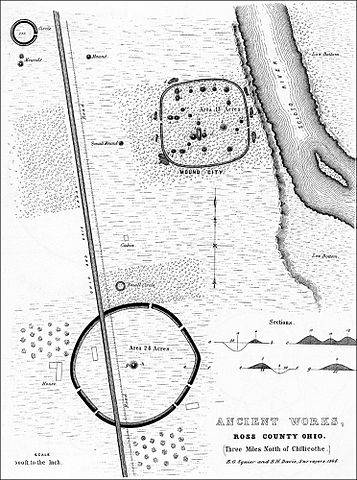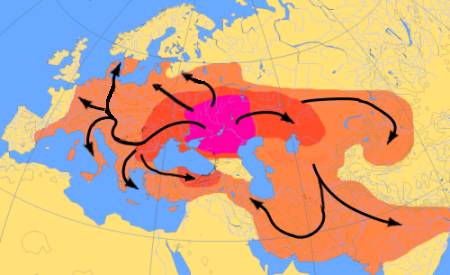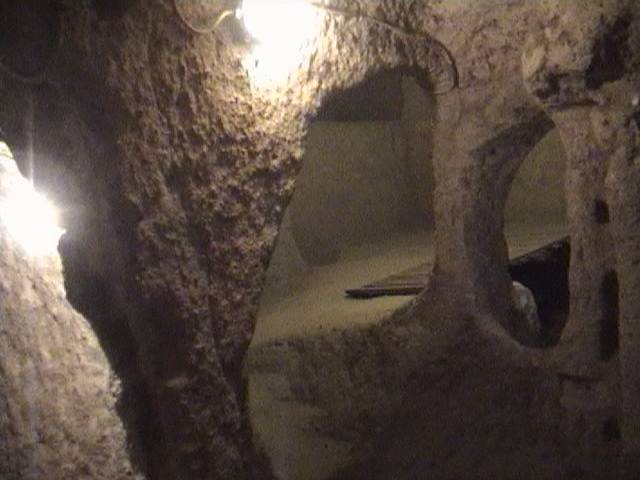The previous hominids

Homo neanderthalensis.
Neanderthals were the previous to Homo Sapiens in the chain of evolving hominids. They appeared approximately 300000 years ago, 150000 years before modern humans. These approximate numbers were adopted at the end of 20 century. Later they were shifted backwards. At the time of coexistence their experience was definitely larger. What is necessary to underline, Neanderthals were specifically European hominid. They lived in Asia too, but the main habitat was West, South, Central, and East Europe. The climate here is colder than in Tropical Africa so this species needed to adapt. These changes proceeded along 2 ways.
First – modifications of the organism. Heat production is proportional to the volume; heat loss – to the surface area. For the ball, the ratio of loss to production will be inversely proportional to its size. Also, it will grow for long objects. In the cold climate, it is more profitable to be large and round; in the hot – small and elongated. Neanderthals had wider skeleton and stronger musculature. Northern climate stimulated growth of hairs. The brain was larger.

Sapiens vs. neanderthal comparison.
Its rear part was enhanced because it contains visual areas and Neanderthals lived in dark caves and the North receives less insolation. Also they had elongated skulls. This relates Neanderthals with Paracas people in Peru. Many cultures worldwide tried to deform their sculls, but Paracas had different bones. Their scull is definitely not that of Neanderthals, but it could evolve from that. Also let's ask, why different peoples exposed their children to such a torturous procedure? Obviously, they believed that it is useful. Probably they remembered somebody with such a head who was more clever and skilled than they were.
Second – behavioral changes. Protection from the cold forces search for natural dwellings such as caves or building artificial ones. Initially historians deemed that people began to build villages with the introduction of agriculture and these villages later grew into towns. Later discoveries showed that the first towns emerged simultaneously with villages and even before agriculture. Neanderthals created their dwellings out of animal skins, large bones, tusks or horns, and stones. Building, making clothes, hunting requires more and more sophisticated tools. Neanderthals even knew technology. They attached the pike to the shaft with a glue.
Neanderthals lived in small collectives and probably used a language for communication. To what level could their society rise? Neanderthals disappeared approximately 30000 years ago. How did it happen? Several hypotheses exist. Their population could gradually decline by itself. They could be pushed aside or even actively terminated by modern humans. This work promotes another version. Neanderthals mixed with Homo Sapiens, formed the ruling class over them, and gradually dissolved in the new generations.
The Near East plays some special role in religion and human history. These places are considered sacred because something important happened there in the past. Levant aka the Mediterranean Corridor is the point of most probable contacts between Neanderthals and Homo Sapiens. Archeology reveals that this area changed hands. The time table correlates with periods of glaciation in East Europe. The 2 last occasions were 170 – 125 and 110 – 70 Ka. Neanderthals lived in the Near East before 100 Ka. Circa 130 and till 80 Ka they were replaced by Homo Sapiens. Neanderthals returned to live from 80 – 55 Ka. From 70 Ka, the second expansion of modern humans started. Obviously, as glaciers retreated, both species moved to the North in search for new territories. The reverse motion was more complicated. In both cases, mixing of populations was possible.
Our civilization took just 10 millennia to grow from primitive agriculture to space flights and nuclear physics. Divide 300000 years of Neanderthal existence by this number and you will see that they had 30 chances to do so. Hard to believe that they didn't use any single one. Meanwhile records hint that they did.
Official history begins with the introduction of writing some 5000 years ago. Before that, humans retained the past in the oral tradition. It is ancient legends that keep vague signs of previous civilizations. Religion uses several meanings for the term god. The Single God is the supreme entity which rules the whole world. Paganic gods rule their local worlds. There is yet another meaning. Non-civilized peoples used this word for a developed civilization existing alongside them. The Old Testament mentions Sons of God which took wives from humans. A clear reference to another civilization which existed in the time of Adam and Eve.
The next point to take into account is how the change of generations happens. We perceive hominids as absolutely different species which replace each other. Indeed, they are just different stages of the same evolution. There was a plateau on the time chart when a certain species was dominant. Then, a transition period followed. This period could be lengthy but much shorter than the plateau. Hence, the number of discovered samples will be negligible and we will perceive it as a sudden jump. Also the progress of archeology shows that the initial classification of Hominids was related to the lack of samples. As the new data emerged, new species were added and gaps between them were filled with intermediate individuals. The overall picture is gradually evolving global population of semi-nomadic tribes. Some clusters of this population became locked in isolated regions for millennia and adapt to their conditions. Then, they mix with others and transfer the acquired knowledge worldwide. The obvious conclusion from this picture is that the previous generation is always on top. They have better experience and teach newcomers how to live in this world.
Again, we have a confirmation from mythology. Prometeus is said to teach humans how to use fire. Archeology tells that fire was used even before Neanderthals. What we know about Neanderthal behavior is the story of Prometeus rewritten in the terms of modern science. They lived in small groups and didn't walk far away from their caves. Prometeus was linked to a rock and an eagle tortured his liver. Cirrhosis is often caused by alcoholism. Did Neanderthals already know winemaking? In any case, there are food-related liver diseases. Neanderthals predominantly consumed meat. Excessive eating of smoked meat increases the risk of cancer. Also hepatitis is a liver disease caused by infection transmitted via food. This may be both viruses and mold from stale products.
All these data lead to the conclusion that white men – typical dwellers of Europe – are descendants from the previous population which simply retained their leading positions. Genetical studies show that 30% of Neanderthal genome survived in modern humans. Among such genes – those which control hairs and skin. Another characteristic feature – genes linked to obesity. Now let's trace how this group evolved already inside the population of modern humans after official disappearance of Neanderthals.

Milankovitch cycles.
This chart shows how the temperature on Earth changed over millennia before Common Era. The unit of time scale is Ka that is thousand of years. This is the sum of several cyclic processes. 2 major components have periods of approximately 100 Ka (maximum marked 1, 2, 3) and 41 Ka (4, 5, 6, 7). The last maximum of temperature was 8000 years ago.

Vostok insolation.
This is the same with a more fine time scale, only the past goes rightwards from present.
Neanderthals ceased to exist approximately 30000 years ago. This corresponds to the extremum on Milankovitch cycle with the period of 41000 years. If the maximum of temperature was circa 10000 years ago, that was the previous minimum. You see 3 cycles of deterioration: 2-5, 5-4, 4-1. That was the worst time from the last 125000 years. Neanderthals disappeared when living conditions worsened so seemingly it was natural, gradual extinction.
39000 years ago the supervolcano in Italy near Naples terminated life in West Europe. Meanwhile, advancing population of modern humans from Africa pushed Neanderthals in the quite definite direction. Namely – to the East. From East Europe they came to South Siberia and finally could reach the Pacific coast. We get confirmation for this immediately. The Ainu people of Pacific islands and the continental Far East were strikingly different from their Mongoloid neighbours, but look very like North Europeans.

Ainu man, circa 1880.
They stored their own legendary history and insisted that they live in these places tens of thousands of years. Also their lifestyle was recorded in the early Japanese chronicles. This description perfectly fits what should be expected from Neanderthals. They were physically stronger, had violent behavior and quite specific image of life. It was clearly advanced, but not a civilization in common meaning. They did not practice production in our sense. Instead, they tried to use natural resources rationally and regulate own consumption and population.
This migration could also reach America. Archeology of Native Americans show wonderful things. There existed a widespread cultures which created large earth structures.

1840s map of Mound City. Hopewell culture.
Similar structures were found in Britain, South Ural and they may be predecessors of Scythian curgans and early Egyptian pyramids built from earth and mud bricks. Also America knows numerous reports of giant human skeletons circa 2.5 m tall.
Gigantism is a well known feature of animals living in cold climate. A large body has a less ratio of the surface to the volume which helps to economize heat production. Indian legends tell that these people were brutal and had conflicts with humans. Possibly, tried to subdue them. Burials show that they may be chiefs upon humans.

Scheme of Indo-European migrations from c. 4000 to 1000 BCE according to the Kurgan hypothesis. The assumed Urheimat (Samara culture, Sredny Stog culture) and the subsequent Yamnaya culture. The central purple area is supposed to show early Yamna culture (4000–3500 BC); the dark red area could show expansion to about 2500 BC, and the lighter red area expansion to about 1000 BC.
Marija Gimbutas placed the origin of Indoeuropeans somewhere between Upper Don and Volga 5000 years BCE. This approximately corresponds to the date of World Creation in Slavic calendar – approximately 5500 BCE. In this chronology, the event is not mystical at all. Just concluding a peace treaty in a great war. In this language, the word for peace and world is the same. Slavo-Aryans defeated Ahriman. In Shahnameh this may correspond to the end of Irano-Turanian war.
Meanwhile this time scale keeps yet another 2 dates. Both are linked to climate change. 110000 BCE Slavs moved from the North because of the Great Flood. 11000 BCE they recorded the great cold. Indeed, 110000 BP began the last glacial period in East Europe. According to data about the level of the Caspian Sea, 10000 BCE ended the last glaciation. This points at yet another factor which pushed Neandertahls from their homeland Europe. During interglacial periods large areas of the continent became flooded. Accordingly, the population moved towards its mountainous marginal regions. As a result, the distribution strikingly similar to the present was created. In the near past, centres of large empires were located not in the centres of some regions, but at their borders (Britain, Japan, even in Russia Peter I moved the capital from Moscow to St. Petersburg).
It is necessary to take into account that geography of Siberia was different millennia ago. During the last glacial period, Ob and Yenisei rivers which flow at the West and East sides of West Siberia were dammed at the mouth by the glacier. As a result the huge inner sea larger than Caspian Sea existed.

Ice Age lakes of Siberia and Central Asia.
This water reservoir should change local climate and make it more soft and favorite for animals and humans. Large human population could thrive at the south shores of this sea. When the glacier melted, the sea disappeared and turned into bogs, humans could migrate westwards to the region of Baltic Sea with similar conditions.
Mountain Shoria is a nearby region full of mystery. There are talks about Yeti the snow man. There are many caves.

Megaliths of Mountain Shoria.
Also this region is often cited as a megalithic site. Neanderthals often lived in caves. Growing population required more room. There are 2 possible solutions. The first – build artificial dwellings. This lineage resulted in modern stone houses and finally in building cities. A medieval castle is nothing else than an artificial rock with many caves inside. As a confirmation, they were often built on top natural rocks end were their extensions.
Another solution – dig more rooms near the existing. The whole cave cities are well known in Cappadocia and other places.

Kaymakli caves.
Also monks later made their monasteries this way in the soft stones. One such underground city existed under Tutal rocks at the bank of the Tom river in West Siberia. Rumors tell about kilometres of underground tunnels. Many children were lost in these caves so they were blown up in 1964.
When archeology discusses Neanderthals and modern humans, they are considered separately. For example, in the Near East, some sites were occupied by both species sequentially. It is supposed by default that one of them abandoned this place, then the other came to it without contact. Meanwhile, besides genetics, such contacts were directly recorded elsewhere. Chatelperronian culture is transitional from Neanderthal to Cromagnon. This may indicate that they lived together. Also, modern humans from Kostenki, Russia lived in typical Neanderthal dwellings. They were made of large bones covered with skins.
Prehistoric Siberia was intensively studied by academician Okladnikov. There is a chain of large cities along 56 parallel. This is the latitude of Moscow and is considered optimal for dwelling. Not too hot and not too cold. Linguistics points at 2 outstanding ethnic groups.
South Ural and adjacent lands were a traditional Tatar area. Science tells that they are a Turkic people, belonging to the language family which emerged at the beginning of Common Era. Meanwhile Greek mythology knows them much longer.
The other group is represented by the Yenisseian language family which dwelled at the eastern shores of the West Siberian sea. This family is much more ancient and retained well known names such as Arins and Kets.

Ket people.
Hittites (Khets) created a famous empire on the territory of Asia Minor. Where did they come from? This event is encircled in mystery. The conquerors retained old names of the previous Hatti and even seemingly adopted their culture. How to explain such respect? Pronunciation of Hittites is similar to Kitai, the Russian name for China. Hatti is similar to Yeti. Were Yenissean Kets a very remote spawn of Hittite Empire or maybe both Hatti and Hittites came to Anatolia from South Siberia? The most probable variant is multiple shuttle migrations between these sites.
All these facts make it possible to formulate a hypothesis that what is known as Indoeuropeans was a group of modern humans led by remains of the previous hominids. They had 150 millennia longer human experience, were specifically adapted to northern climate and high mountains so were well suited to form a ruling class over the next generations.
Now let's look how this subgroup evolved further already as a part of Homo Sapiens. The first civilized communities separated into pastoralists and peasants which correspond to hunters and gatherers of Stone Age. Neanderthals were predominantly hunters so they should be linked to the later nomadic herders.